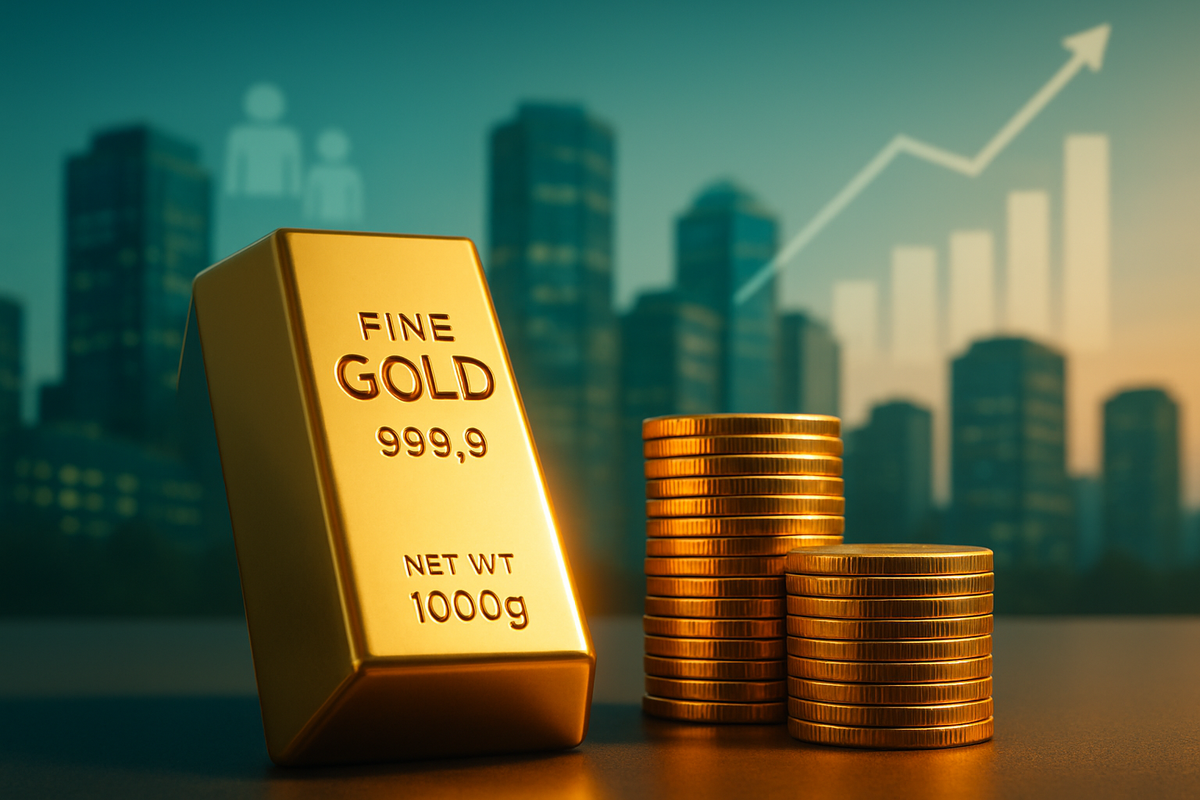
The perennial question of gold's role in an evolving economic landscape takes center stage as the U.S. labor market continues to exhibit remarkable stability. Traditionally, a robust and healthy job market, signaling broader economic strength, tends to diminish the appeal of safe-haven assets like gold. Investors, buoyed by confidence in growth prospects, often pivot towards riskier, higher-yielding assets, leaving gold's luster somewhat dimmed. However, in an era marked by persistent geopolitical tensions and evolving monetary policies, the conventional wisdom surrounding gold's inverse relationship with economic stability is being re-examined.
This article delves into the intricate dynamics between a stable U.S. labor market and the investment demand for gold. While a strong economy typically reduces the immediate need for gold as a hedge against uncertainty, emerging factors suggest a more nuanced picture. We explore whether sustained employment growth, coupled with other global influences, could paradoxically bolster gold's attractiveness, not merely as a safe haven, but as a strategic component of a diversified portfolio even amidst economic calm. The implications for investors and public companies are significant, as they navigate a market where traditional correlations may be undergoing a subtle but profound shift.
A Shifting Paradigm: Gold's Resilience Amidst Labor Market Strength
The U.S. labor market has demonstrated remarkable resilience, a factor that, in traditional economic models, would typically cast a shadow on gold's allure. However, the period leading up to September 2025 has seen gold prices defy conventional expectations, scaling unprecedented peaks even as employment figures remain robust. This phenomenon is a testament to a complex interplay of monetary policy, geopolitical volatility, and evolving investor sentiment.
Historically, a strong labor market signals a healthy economy, often prompting the Federal Reserve (Fed) to consider tighter monetary policies, such as raising interest rates. Higher rates increase the opportunity cost of holding non-yielding assets like gold, making interest-bearing alternatives more attractive. Furthermore, a strong U.S. economy tends to bolster the U.S. dollar, making dollar-denominated gold more expensive for international buyers and thus dampening demand. However, the current landscape reveals a nuanced picture where gold's momentum persists despite these traditional headwinds.
The timeline of events from late 2024 to the present (September 30, 2025) illustrates this shift. While the FOMC maintained a restrictive federal funds rate through mid-2024, aiming to tame sticky inflation, gold prices began their ascent. A mixed jobs report in August 2024 initially caused gold to ease, but a significant rally ensued in late 2024, pushing gold past $2,600/oz, fueled by geopolitical risks and consistent central bank buying. The Fed's December 2024 rate cut, citing an increase in unemployment, further buoyed gold. By early 2025, gold had shattered previous records, peaking at $3,500/oz in April and trading above $3,932/oz by May 7, driven by escalating global tensions and expectations of further rate cuts. Even as the U.S. labor market showed continued strength in July 2025, with private sector job creation exceeding expectations, gold held firm above $3,300, demonstrating its newfound resilience. A weak jobs report in August 2025, boosting rate cut expectations, saw gold hold steady at $3,590. As of September 2025, gold has surged to new record highs, surpassing $3,860 per ounce, propelled by safe-haven demand amidst U.S. government shutdown concerns, stable inflation data, and anticipation of further Fed easing. Even a preliminary revision subtracting nearly one million jobs in early September caused initial volatility but gold later stabilized, showing little significant reaction to a subsequent rise in job openings.
Key players in this dynamic include the Federal Reserve, whose monetary policy decisions, heavily influenced by labor market data and inflation, remain a primary driver. Fed Chair Jerome Powell's recent emphasis on balancing inflation risks with a weakening jobs market underscores the delicate tightrope walk. Investors, both institutional and retail, are increasingly diversifying into gold, as evidenced by rising Gold Exchange-Traded Fund (ETF) inflows, seeking portfolio protection against broader uncertainties. Crucially, central banks globally have emerged as a dominant force, aggressively increasing their gold reserves since 2020 and continuing at near-record highs in 2025. This institutional buying, driven by diversification away from the U.S. dollar, geopolitical concerns, and long-term inflation worries, provides a robust price floor for gold. While initial market reactions to strong jobs data might still see a temporary dip in gold, the overarching trend suggests that multiple factors are now underpinning gold's demand, allowing it to thrive even in an otherwise stable economic environment.
Several interconnected factors are currently supporting gold's demand, even amidst a stable U.S. labor market. Persistent inflation concerns, despite central bank efforts, drive investors to gold as a hedge against the erosion of purchasing power. The Fed's willingness to allow inflation to exceed targets, prioritizing employment, makes gold more attractive. Heightened geopolitical risks, from ongoing regional conflicts to trade disputes and domestic political instability (such as the looming U.S. government shutdown), continue to fuel safe-haven demand. Central bank buying remains a critical structural support, with over 1,000 tonnes purchased annually from 2022-2024, projected to exceed 1,300 tonnes in 2025, as nations diversify reserves. A weakening U.S. dollar (down over 9% year-to-date by September 2025) and broader de-dollarization trends make gold more appealing internationally. Finally, expectations of future Fed rate cuts, with markets pricing in a high probability for October and December, reduce the opportunity cost of holding gold, further contributing to its upward momentum. These combined forces are reshaping gold's traditional role, allowing its luster to shine even as the labor market stands strong.
Corporate Fortunes: Winners and Losers in Gold's Resurgence
The sustained surge in gold prices, propelled by a confluence of geopolitical tensions, inflation concerns, and robust central bank buying, is creating a distinct landscape of winners and losers across various public companies. Even as the U.S. labor market maintains its stability, typically a deterrent for safe-haven assets, gold's exceptional performance in late 2025 is reshaping corporate fortunes.
The most direct beneficiaries are gold mining companies. With gold prices exceeding $3,800 per ounce, these companies are experiencing significantly enhanced revenues and profit margins. Their production costs, generally ranging from $1,080 to $1,220 per ounce for major players, remain relatively stable, leading to operational leverage where a small percentage increase in gold price translates into a much larger boost in profitability. Giants like Newmont Corporation (NYSE: NEM), the world's largest gold miner, have seen robust stock performance, with its stock reportedly up 80% year-to-date in 2025. Other major players like Barrick Gold (NYSE: GOLD), Agnico Eagle Mines Limited (NYSE: AEM), Alamos Gold Inc. (NYSE: AGI), and Kinross Gold (NYSE: KGC) are also reaping substantial rewards, incentivizing increased exploration and production.
Gold Exchange-Traded Funds (ETFs) are another clear winner, as they offer investors liquid exposure to gold prices without direct physical ownership. Funds like SPDR Gold Shares (NYSEARCA: GLD), iShares Gold Trust (NYSEARCA: IAU), and GraniteShares Gold Trust (NYSEARCA: BAR) have seen significant inflows, reaching record assets under management (AUM) levels. These ETFs serve as a popular conduit for both institutional and retail investors seeking to capitalize on gold's upward trajectory. Furthermore, royalty and streaming companies, such as Franco-Nevada Corporation (NYSE: FNV), Royal Gold Inc. (NASDAQ: RGLD), and Wheaton Precious Metals Corp. (NYSE: WPM), benefit immensely. They provide upfront capital to miners in exchange for a percentage of future production or revenue, offering a lower-risk, high-leverage exposure to rising gold prices. Gold refiners, bullion dealers, and financial institutions involved in commodity trading and hedging solutions for miners also stand to gain from increased market activity.
Conversely, some sectors face headwinds as gold gains prominence. Jewelry retailers are paradoxically challenged by record-high gold prices. The escalating cost of raw gold translates into higher retail prices for finished jewelry, which typically stifles consumer demand. Consumers may opt for smaller designs or, more significantly, shift their purchasing towards gold bars and ingots as a direct investment rather than decorative pieces. Publicly traded jewelry companies heavily reliant on gold sales could see a contraction in their margins and sales volumes.
Moreover, if investors increasingly favor gold as a primary safe-haven and inflation hedge, capital could be diverted from other asset classes. This could negatively impact certain equities and bonds, particularly those perceived as riskier or offering lower real returns compared to gold's perceived stability and capital appreciation in an inflationary environment. Companies in highly cyclical sectors or speculative growth stocks might see reduced investment interest. While the S&P 500 has shown growth, gold's strong performance presents competition, potentially drawing capital away from broad market indices. Other commodities and alternative investments might also experience relative underperformance if gold becomes the preferred investment vehicle. Even cryptocurrencies like Bitcoin, often touted as "digital gold," could see a relative shift in investor preference back to physical gold during periods of intense geopolitical and economic uncertainty. Lastly, Real Estate Investment Trusts (REITs), while offering some inflation protection, are sensitive to interest rates. If a stable labor market leads to interest rate decisions that are less favorable for real estate (e.g., higher rates or slower cuts to combat inflation), REITs could face headwinds, potentially diverting investment to gold.
In essence, the current economic climate, where a stable U.S. labor market coexists with persistent inflation and geopolitical instability, has solidified gold's role as a critical investment. This environment creates a clear divide, significantly boosting companies in the gold ecosystem while potentially siphoning investment and demand from other sectors.
A New Global Order: Gold's Enduring Significance in a Fragmented World
The unprecedented surge in gold's investment demand, even as the U.S. labor market exhibits a degree of stability, signals a profound re-evaluation of its role in the global financial system. As of September 30, 2025, gold prices have shattered records, trading between $3,842.76 and $3,866.90 per ounce, with December futures nearing $3,900. This remarkable ascent, a 45% increase since the start of 2025, transcends mere safe-haven buying; it reflects deeper structural shifts in monetary policy, geopolitical alignment, and investor perception.
This phenomenon is deeply intertwined with several broader industry trends. Foremost is the persistent central bank accumulation of gold, a structural shift in global reserve management that has seen central banks acquire over 1,000 metric tons annually since 2022, continuing robustly into 2025. This trend is a cornerstone of the broader monetary system evolution and de-dollarization efforts, as nations, particularly emerging economies and BRICS members, actively seek to reduce their reliance on the U.S. dollar. The dollar's share of global reserves has reportedly declined from over 70% in 2000 to approximately 58% in 2025, while gold's share has risen to nearly 15%, indicating a significant recalibration of global monetary reserves. This strategic diversification is a response to heightened geopolitical instability, with ongoing conflicts in Eastern Europe and the Middle East, trade disputes, and electoral uncertainties fueling a consistent demand for neutral, physical assets. Furthermore, inflationary concerns remain potent; despite some stabilization projections, U.S. core Personal Consumption Expenditures (PCE) inflation stood at 4.6% in Q3 2025, reinforcing gold's appeal as a hedge against currency debasement. Strong investment flows into gold ETFs and physical bullion, coupled with global gold supply constraints (mine production has plateaued around 4,000 metric tons annually for six years), further intensify gold's price sensitivity to increased demand.
The ripple effects of gold's ascendance are far-reaching. Its traditional competitors as safe havens, primarily U.S. Treasuries and the U.S. dollar, are facing increasing scrutiny. Domestic political instability, rising national debt, and geopolitical fragmentation are undermining their "risk-free" reputation, leading investors to diversify into gold. While cryptocurrencies like Bitcoin offer a digital alternative, their inherent volatility and regulatory uncertainties still limit their full safe-haven status for many institutional investors. For partners in the mining industry, record gold prices offer a positive outlook, yet they grapple with challenges such as rising production costs, labor shortages, and energy price volatility. However, governmental incentives in regions like Argentina and Saudi Arabia are aimed at bolstering the sector. Financial institutions are also adapting, with Basel III regulations upgrading gold to a Tier 1 asset, providing a powerful incentive for commercial banks, particularly in Europe, to increase their gold holdings for capital adequacy and risk management. This shift also impacts commodity and currency markets, as gold's strength often correlates with other precious metals, and a weakening U.S. dollar further boosts international demand.
Regulatory and policy implications are significant. The Federal Reserve's monetary policy, including recent interest rate cuts (such as the 25-basis-point cut on September 17, 2025) and its willingness to tolerate higher inflation, directly influences gold prices by reducing the opportunity cost of holding the non-yielding asset. Basel III regulations have fundamentally enhanced gold's financial standing, encouraging commercial banks to hold more. The broader de-dollarization initiatives by various nations inherently bolster gold's strategic importance as a neutral reserve asset, less vulnerable to international financial restrictions. Even taxation policies, such as the U.S. IRS classifying gold as a "collectible" with higher capital gains taxes, subtly influence investor behavior, often encouraging longer-term holding for hedging purposes.
Historically, the current situation draws parallels to the 1970s inflationary period, when gold surged over 2,300% after the U.S. abandoned the gold standard, demonstrating its prowess as an inflation hedge. Gold has also consistently performed as a safe haven during major financial crises (2008, 2010-2012, 2020) and geopolitical upheavals. Crucially, the dramatic reversal in central bank behavior—from net sellers for two decades to aggressive net buyers post-2010 and accelerating post-2020—underscores a profound global re-evaluation of gold as an essential strategic asset in monetary policy and reserve management. Gold's historical performance, particularly when U.S. inflation exceeds 3%, delivering average annual returns of 14.9%, reinforces its enduring appeal.
At the heart of gold's renewed significance are three intertwined themes: de-dollarization, inflation hedging, and the changing role of safe havens. De-dollarization represents a long-term structural shift by nations seeking financial independence and risk mitigation, providing a robust floor for gold prices. In an environment of persistent inflation, gold's limited supply and intrinsic value make it a highly prized hedge against the erosion of purchasing power. Finally, the traditional hierarchy of safe havens is being redefined. With U.S. Treasuries and the dollar facing scrutiny, gold, as a physical, non-sovereign asset with no credit risk and a millennia-long history of value preservation, is increasingly perceived as a more reliable and neutral "financial backstop." This makes gold a crucial component of diversified risk management strategies for investors navigating an increasingly volatile and unpredictable global economy.
The Road Ahead: Gold's Trajectory in an Evolving Economic Landscape
The trajectory of gold investment demand, even against the backdrop of a stable U.S. labor market, is poised for continued strength, driven by a complex interplay of monetary policy, geopolitical realities, and central bank strategies. As of September 30, 2025, the outlook for gold remains largely bullish, reflecting a fundamental re-evaluation of its role as a cornerstone asset for financial stability.
In the short-term (next 6-12 months), gold is widely expected to maintain its robust momentum. Analysts project prices to stabilize between $3,700 and $3,900 as 2025 concludes, with a strong consensus for surpassing $4,000 per ounce by mid-2026. The Federal Reserve's ongoing rate-cutting cycle, with markets pricing in a high probability of further cuts in October and December, will be a primary catalyst. Lower interest rates reduce the opportunity cost of holding non-yielding gold, making it more attractive relative to interest-bearing assets. Persistent geopolitical risks, from ongoing conflicts to political uncertainties, will continue to fuel safe-haven demand. While short-term profit-taking may introduce minor corrections, these are likely to be viewed as buying opportunities, underpinned by strong structural demand.
Looking further into the long-term (1-5 years and beyond), the outlook for gold is overwhelmingly bullish. Many financial institutions forecast prices ranging from $4,000-$5,000 per ounce by mid-2026, with some projections reaching $4,800 to $8,900 by 2030 if current trends persist. Gold's role as a hedge against persistent inflation, particularly if inflation remains above central bank targets, will be a significant driver. The ongoing de-dollarization trend, with central banks aggressively diversifying their reserves away from the U.S. dollar, will continue to bolster demand. This fundamental shift in central bank purchasing and sustained private investor interest reinforces gold's position as an essential asset for financial stability in an increasingly uncertain global economy.
For investors, strategic pivots and adaptations are crucial. A long-term perspective, viewing gold as a cornerstone asset for financial stability, is paramount. The "buy the dip" strategy during short-term corrections could prove effective. Close monitoring of real yields, Fed policy shifts, inflation data, and geopolitical developments will be essential. Investment vehicles span physical gold (bars, coins), gold mining stocks, and gold-backed ETFs, each offering different risk-reward profiles.
Market opportunities abound, primarily driven by continued price appreciation potential, gold's proven ability to preserve purchasing power during inflationary periods, and sustained safe-haven demand amidst geopolitical tensions. The consistent accumulation by central banks provides a structural demand floor, while the rise of digital gold offers new avenues for investment. Gold mining companies could also see enhanced margins if energy costs are contained. However, challenges exist. A hypothetical hawkish pivot by the Fed, leading to sustained higher interest rates, or a significant strengthening of the U.S. dollar could create headwinds. A substantial easing of global geopolitical tensions could diminish safe-haven demand, and a robust equity market might divert capital. Mining companies also face the ongoing challenge of cost management and the potential for resource nationalism.
Several potential scenarios could unfold. In a strong bullish scenario, intensifying geopolitical conflicts, stubbornly high inflation, and an accommodative Fed with aggressive rate cuts could propel gold towards $4,000-$5,000 per ounce, reinforced by central bank and private investor accumulation. A moderate growth with consolidation scenario would see rate cuts proceed and inflation gradually moderate, with gold prices consolidating at high levels, maintaining an upward trend at a more measured pace, supported by persistent safe-haven and central bank demand. A corrective pullback, while less likely long-term, could occur if an unexpectedly robust U.S. economy, rapid disinflation, and a more hawkish Fed stance emerge, or if geopolitical tensions ease significantly. However, strong structural demand from central banks and inflation hedging would likely limit significant downside, keeping prices generally above pre-2025 levels. The interaction between a stable (or slightly weakening) labor market and these powerful drivers will continue to shape gold's compelling narrative in the years to come.
Conclusion: Gold's Enduring Relevance in a Complex Economy
The journey through gold's investment demand in the context of a stable U.S. labor market reveals a narrative far more intricate than traditional economic models might suggest. As of September 30, 2025, the market has demonstrated that even with robust employment figures, gold's luster is not diminished but rather reinforced by a confluence of global economic and geopolitical factors.
Key Takeaways: The article has highlighted that while a strong U.S. labor market might traditionally reduce the immediate need for safe-haven assets, gold's appeal is sustained by its formidable role as an inflation hedge. Persistent inflationary pressures, coupled with the Federal Reserve's accommodative monetary policy (evidenced by ongoing rate cuts), reduce the real cost of holding non-yielding gold. Furthermore, a weakening U.S. dollar, often influenced by rate cut expectations, makes gold more attractive to international buyers. Crucially, the overriding factor remains gold's undisputed status as a safe haven amidst pervasive geopolitical tensions and global economic uncertainties, acting as a "barometer of global risk."
Assessing the Market Moving Forward: The gold market has witnessed unprecedented momentum throughout 2025, with prices consistently surpassing $3,800 per ounce, driven by aggressive central bank buying, persistent geopolitical instability, and expectations of further Fed rate cuts. Major financial institutions largely project continued upward momentum, with many analysts forecasting prices to stabilize in the $3,700-$4,000 range by late 2025 and potentially exceeding $4,000 per ounce by mid-2026. This bullish sentiment is underpinned by a fundamental shift in global reserve management strategies and gold's proven resilience as a store of value.
Final Thoughts on Significance and Lasting Impact: This exploration underscores gold's enduring significance as a multi-faceted asset. Economic "stability," particularly in the labor market, does not negate the fundamental drivers of gold demand when viewed through a wider lens of global risks, inflation concerns, and evolving monetary policies. The lasting impact is a paradigm shift: gold is increasingly recognized as a crucial portfolio diversifier against complex, interconnected global risks, rather than merely a crisis asset. Its ability to retain value across diverse economic scenarios is cementing its position as a cornerstone investment for both institutional and individual portfolios in an unpredictable world.
What Investors Should Watch For in Coming Months: Investors should remain vigilant, closely monitoring several key indicators. The Federal Reserve's monetary policy will be paramount; any further interest rate adjustments or shifts in guidance will significantly impact gold. Inflation reports, such as the monthly Consumer Price Index (CPI), will continue to be critical in assessing gold's value as a hedge. Geopolitical developments—ongoing conflicts, trade tensions, and political instability—will remain a primary driver of safe-haven demand. The U.S. Dollar Index (DXY) should be tracked, as a weakening dollar generally supports gold prices. Investors should also observe central bank gold purchase reports for indications of sustained institutional demand. Finally, while a strong U.S. labor market generally implies stability, any unexpected weakness could trigger safe-haven buying, while overheating with significant wage inflation could reinforce gold's inflation-hedge appeal. For tactical investors, observing key technical price levels will also be important for navigating short-term movements and confirming trend strength.
This content is intended for informational purposes only and is not financial advice.






